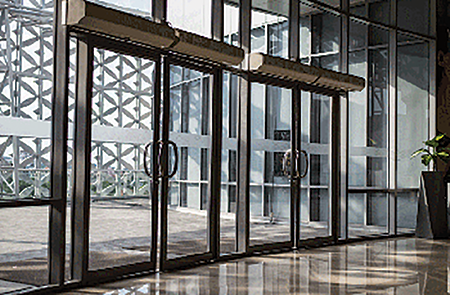
By / Norm Grusnick, P.Eng
Good news for building owners, engineers, architects, and HVAC contractors who can now save energy, construction costs, and space in commercial facilities with the latest code update. ASHRAE, the leading policy maker for the heating, refrigeration, and air conditioning industry, has formally approved the use of properly certified and installed air curtains as an exception to the vestibule requirement.
Consulting engineers and architects who previously were hesitant to replace vestibules with air curtains due to inconsistent code language now have the support of ASHRAE Standard 90.1-2019. Furthermore, sheet metal contractors will see a spike in air curtain installations to accommodate facilities looking to prevent energy loss through their main entries and meet building codes. Also, air curtains can now be a recommendation for value engineering because they are roughly only about 10 percent of the total cost of a vestibule in time and materials.
Office and other commercial buildings can now look at retrofitting vestibules and repurpose the space (anywhere from 40-300 square feet) for more productive purposes. Studies have shown that air curtains are equal or more efficient than two-door vestibules as energy savers. Also, air curtains protect against the infiltration of outdoor air, flying insects, wind, and dust through open doorways.

Vestibules maintain an air lock and discourage an open wind tunnel effect where conditioned air rushes through two doors open simultaneously. Unfortunately, the concept is easily defeated by both doors opening at the same time. Air curtain technology draws interior air from the facility and discharges it through long linear nozzles across the doorway.
A properly sized air curtain uses approximately 70-85 percent of the conditioned expensive indoor air and returns it to the space. Also the air curtain separates the indoor/outdoor environments by maintaining AMCA-certified minimum velocities of 400 ft/min at the floor. An air curtain is typically activated by limit activated controls. When the door is closed the options are also available for supplemental heating.
A Canadian University – Concordia- Dr. Liangzhu Wang conducted two third-party studies, “Investigation of the Impact of Building Entrance Air Curtain on Whole Building Energy Use” in 2013 and “Energy Saving Impact of Air Curtain Doors in Commercial Buildings” in 2016. Dr. Wang’s studies concluded that, on average, air curtain protected doorways were proven to save total building energy usage by a factor of 0.3 to 2.2 percent more over that of vestibules.
These studies, as well as ANSI/AMCA Standard 220, which states air curtains maintain 400 ft/min airstream velocity, led to changes in ASHRAE 90.1-2019.



